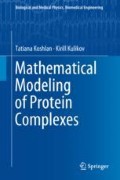Abstract
This chapter presents a new method that allows one to qualitatively determine the effect of point mutations in peptides on the stability of the formed complex with full-length proteins. On the basis of the developed approach, a qualitative correlation of the obtained results with the dissociation constant was revealed using the example of the formation of the BH3 peptide biological complex of Bmf, Puma, Bad, Hrk, Bax, Bik, Noxa, Bid, Bim, and Bak proteins with the Bcl-xl protein and the BH3 peptides protein Bax with the Bcl-2 protein, taking into account the replacement of amino acid residues.
Access this chapter
Tax calculation will be finalised at checkout
Purchases are for personal use only
References
B. Santiago, I. Gutierrez-Canas, J. Dotor, G. Palao, J.J. Lasarte, J. Ruiz, J. Prieto, F. Borras-Cuesta, J.L. Pablos, Topical application of a peptide inhibitor of transforming growth factor-\(\beta \)1 ameliorates bleomycin-induced skin fibrosis. J. Investig. Dermatol. 125(3), 450–455 (2005)
N. Suzuki, S. Hazama, H. Iguchi, K. Uesugi, H. Tanaka, K. Hirakawa, A. Aruga, T. Hatori, H. Ishizaki, Y. Umeda, T. Fujiwara, T. Ikemoto, M. Shimada, K. Yoshimatsu, R. Shimizu, H. Hayashi, K. Sakata, H. Takenouchi, H. Matsui, Y. Shindo, M. Iida, Y. Koki, H. Arima, H. Furukawa, T. Ueno, S. Yoshino, Y. Nakamura, M. Oka, H. Nagano, Phase II clinical trial of peptide cocktail therapy for patients with advanced pancreatic cancer: VENUS-PC study. Cancer Sci. 108(1), 73–80 (2017)
R. Arafeh, K. Flores, A. Keren-Paz, G. Maik-Rachline, N. Gutkind, S. Rosenberg, R. Seger, Y. Samuels, Combined inhibition of MEK and nuclear ERK translocation has synergistic antitumor activity in melanoma cells. Sci. Rep. 7(1), 16345 (2017)
H. Dai, X.W. Meng, S.H. Kaufmann, BCL2 family, mitochondrial apoptosis, and beyond. Cancer Transl. Med. 2(1), 7–20 (2016)
J. Ding, Z. Zhang, G.J. Roberts, M. Falcone, Y. Miao, Y. Shao, X.C. Zhang, D.W. Andrews, J. Lin, Bcl-2 and Bax interact via the BH1-3 groove-BH3 motif interface and a novel interface involving the BH4 motif. J. Biol. Chem. 285(37), 28749–28763 (2010)
V. Bhat, M.B. Olenick, B.J. Schuchardt, D.C. Mikles, C.B. McDonald, A. Farooq, Molecular determinants of the binding specificity of BH3 ligands to BclXL apoptotic repressor. Biopolymers 101(6), 573–582 (2014)
P.E. Czabotar, G. Lessene, A. Strasser, J.M. Adams, Control of apoptosis by the Bcl-2 protein family: implications for physiology and therapy. Nat. Rev. Mol. Cell Biol. 15(1), 49–63 (2014)
N. Echeverry, D. Bachmann, F. Ke, A. Strasser, H.U. Simon, T. Kaufmann, Intracellular localization of the BCL-2 family member BOK and functional implications. Cell Death Differ. 20(6), 785–799 (2013)
T. Moldoveanu, Q. Liu, A. Tocilj, M. Watson, G. Shore, K. Gehring, The X-ray structure of a BAK homodimer reveals an inhibitory zinc binding site. Mol. Cell 24(5), 677–688 (2006)
H. Wang, C. Takemoto, R. Akasaka, T. Uchikubo-Kamo, S. Kishishita, K. Murayama, T. Terada, L. Chen, Z.J. Liu, B.C. Wang, S. Sugano, A. Tanaka, M. Inoue, T. Kigawa, M. Shirouzu, S. Yokoyama, Novel dimerization mode of the human Bcl-2 family protein Bak, a mitochondrial apoptosis regulator. J. Struct. Biol. 166(1), 32–37 (2009)
M. Suzuki, R.J. Youle, N. Tjandra, Structure of Bax: coregulation of dimer formation and intracellular localization. Cell 103(4), 645–654 (2000)
T. Moldoveanu, A.V. Follis, R.W. Kriwacki, D.R. Green, Many players in BCL-2 family affairs. Trends Biochem. Sci. 39(3), 101–111 (2014)
A.M. Petros, A. Medek, D.G. Nettesheim, D.H. Kim, H.S. Yoon, K. Swift, E.D. Matayoshi, T. Oltersdorf, S.W. Fesik, Solution structure of the antiapoptotic protein bcl-2. Proc. Natl. Acad. Sci. USA 98(6), 3012–3017 (2001)
M.G. Hinds, M. Lackmann, G.L. Skea, P.J. Harrison, D.C. Huang, C.L. Day, The structure of Bcl-w reveals a role for the C-terminal residues in modulating biological activity. EMBO J. 22(7), 1497–1507 (2003)
C. Correia, S.H. Lee, X.W. Meng, N.D. Vincelette, K.L. Knorr, H. Ding, G.S. Nowakowski, H. Dai, S.H. Kaufmann, Emerging understanding of Bcl-2 biology: implications for neoplastic progression and treatment. Biochem. Biophys. Acta. 1853(7), 1658–1671 (2015)
G. Lessene, P.E. Czabotar, P.M. Colman, BCL-2 family antagonists for cancer therapy. Nat. Rev. Drug Discov. 7(12), 989–1000 (2008)
C. Billard, BH3 mimetics: status of the field and new developments. Mol. Cancer Ther. 12(9), 1691–1700 (2013)
H. Puthalakath, A. Strasser, Keeping killers on a tight leash: transcriptional and post-translational control of the pro-apoptotic activity of BH3-only proteins. Cell Death Differ. 9(5), 505–512 (2002)
M.C. Wei, T. Lindsten, V.K. Mootha, S. Weiler, A. Gross, M. Ashiya, C.B. Thompson, S.J. Korsmeyer, tBID, a membrane-targeted death ligand, oligomerizes BAK to release cytochrome c. Genes Dev. 14(16), 2060–2071 (2000)
A. Letai, M.C. Bassik, L.D. Walensky, M.D. Sorcinelli, S. Weiler, S.J. Korsmeyer, Distinct BH3 domains either sensitize or activate mitochondrial apoptosis, serving as prototype cancer therapeutics. Cancer Cell 2(3), 183–192 (2002)
G. Dewson, Interplay of Bcl-2 proteins decides the life or death fate. Open Cell Signal. J. 3, 3–8 (2011)
B. Ku, C. Liang, J.U. Jung, B.H. Oh, Evidence that inhibition of BAX activation by BCL-2 involves its tight and preferential interaction with the BH3 domain of BAX. Cell Res. 21, 627–641 (2011)
Author information
Authors and Affiliations
Corresponding author
Rights and permissions
Copyright information
© 2018 Springer Nature Switzerland AG
About this chapter
Cite this chapter
Koshlan, T., Kulikov, K. (2018). Mathematical Modelling of the Interaction of BH3-Peptides with Full-Length Proteins, and Account of the Influence of Point Mutations on the Stability of the Formed Biological Complex on the Example of the Bcl-2 Family Proteins. In: Mathematical Modeling of Protein Complexes. Biological and Medical Physics, Biomedical Engineering. Springer, Cham. https://doi.org/10.1007/978-3-319-98304-2_7
Download citation
DOI: https://doi.org/10.1007/978-3-319-98304-2_7
Published:
Publisher Name: Springer, Cham
Print ISBN: 978-3-319-98303-5
Online ISBN: 978-3-319-98304-2
eBook Packages: Physics and AstronomyPhysics and Astronomy (R0)

